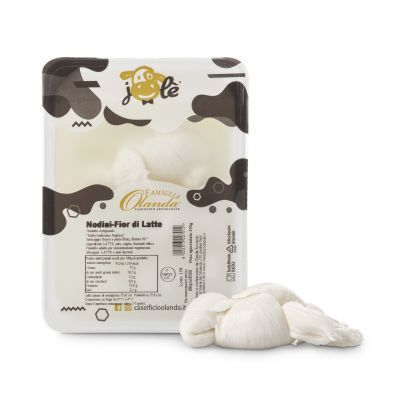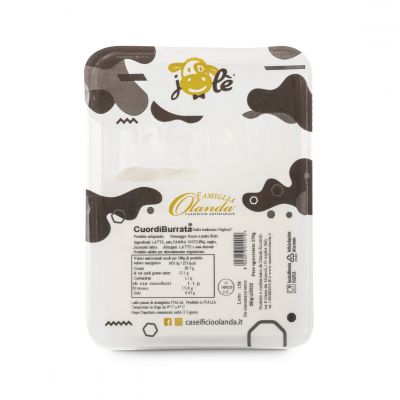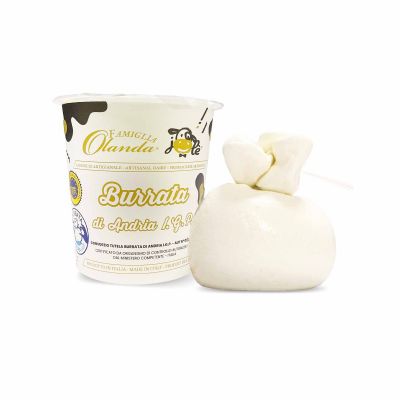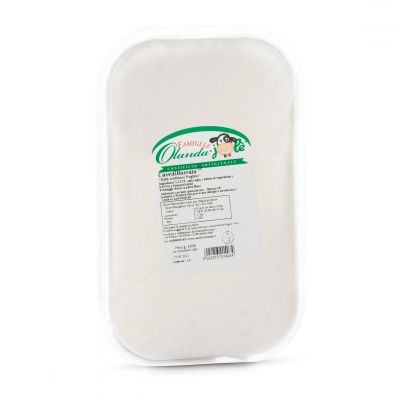"TODAY I'LL LET YOU PUT HANDS IN THE DOUGH": WE LEARNT HOW TO SHAPE NODINI AND RIP MOZZARELLA STRIPS BY HAND, BUT ABOVE ALL WE UNDERSTOOD WHAT THE WORD "ARTISANAL" MEANS

"These days you must feel at home": this is how Riccardo Olanda greets us as we get into his car at Bari airport. It's raining, the sky is grey, it doesn't feel like being in Puglia.
We arrive on the doorstep of Andria, and the "City of Burrata" sign reminds us of the reason for our trip: to experience first-hand the processing of the most artisanal dairy product of our selection. Eventually we did it! We have been working with the Caseificio Olanda for thirty years, in which we have grown together, slowly, respecting a dairy that is truly artisanal by choice, in terms of size, craftsmanship and vision.
We park next to the shop, in a historic building on a city street. Sheets of mozzarella filled with vegetables and stuffed scamorza colour the counter, where mozzarella and burrata are the true stars. At the counter, Grandpa Michele, every day from opening until 8.30 p.m. when the shop closes: he is eighty years and does not feeling them! We ask him if he doesn't get tired of spending so much time at the dairy, but his answer is tranchant: "this is my life and my family, where else should I go but here?" By the way, Grandma Carmela is no less. She oversees the other shop, the one closer to their home, just outside Andria.
It is them, Carmela and Michele Olanda, who founded the dairy in 1988, in exactly the same building where it is now, in the centre of Andria. They are the roots of a truly bonded family, who meet every day to have lunch together in the loft above the dairy. Three generations working together with passion: the dairy at the very heart of the whole family, a life of sacrifice, commitment, dedication, but also providing many recognitions and satisfactions.
“Martì, we don't want to move away from here, this is our home and this is our size; we don't want to grow bigger, we want to keep working at our best with the clients who have known and chosen us for so many years." 
We thought it was just a stop to see the shop, but Riccardo opens a door next to the counter that leads up a steep staircase, on the right the entrance to the dairy. Thick tuff walls, a barrel vault: the dairy is incredibly built inside an old masseria. "Once there was a stable here, my grandfather lived just in front and above him his sons: they used to sell milk house to house, with the bicycle. In 1975 they gave away the animals and bought the fields near Castel del Monte, mainly olive groves and vineyards, now managed by Savino, my brother - Riccardo tells us - but I always prefered to go helping my uncle, who had a small dairy: it was already in my blood”. So in 1988 Michele decided to set up the dairy. And here we are.
A small lift leads upstairs where the products are packed, to be moved then down again for shipping. Spaces are really small but optimised to the centimetre, the guys litteraly work side by side. They receive the polystyrene boxes every day, because there is no space to store them. For the past three years they have been working on an enlargement project: they managed to rent the building next door, where they have carved out some cells in order to move just the packaging area to a room next to the production, improving the cold chain management and making shipping more efficient.
We meet Riccardo's three sons: Michele, the eldest, is 28 years old and mainly works in administration, together with another Riccardo - Alicino his surname, a historical employee of the company; Antonio and Alessandro, 24 and 20 years old respectively, rather work in production. Antonio is also experiencing the selling, he is the most chatty of the three, in his eyes the grit and the desire to tell of his passion for the family business.
Let's start as usual with the milk: the dairy transforms only milk from the Murgia area, collected from three cowsheds with whom the Olanda family has been working with for many years: one in Andria and two in Crispiano. The dairy works from Monday to Saturday, 20 to 30 quintals of milk per day depending on the season. Processing starts very early: it is Riccardo who opens the dairy around 3-3.30am, pasteurises the milk, and heats it so that it is ready when the guys arrive a little later: "In addition to the family we have six guys working in production, all of them longstanding. It's a hard work, and it's difficult to find guys who want to do it nowadays".
Antonio explains us how the processing takes place, while Riccardo is heating the milk in a small 200-litre vat, laughing: "Today I'll let you dirty your hands". I am quite worried, the curd stretching takes place at high temperatures, 85-90°C.
"We mainly pasteurise the milk, but also make a few products with raw milk and milk starters for the local market."
After heating the milk up to 34-36°C, ferments are added first, then microbic liquid rennet. The curd is broken up and left to ripen under whey for 2-3 hours. I wash my hands, put on my "Olanda uniform" and I'm ready.
The curd is cut into blocks and moved to the processing table, where it is crumbled by hand. Next to us, in a big kettle, the water is reaching a temperature of 90°C. And here comes the magic: the water is poured a little at a time onto the curd, which is then kneaded with a kind of sword, as long as it starts to stretch. With patience, we keep pouring the water and stretching the curd, until it becomes one smooth, homogeneous dough. "Now let's make Nodini (the knots)" - Riccardo tells me, and shows me at 2x speed how to do it. Too fast, let's try again!
We dip our hands into a bowl of cold water, then immediately into the boiling water to grab a part of the curd. We stretch it quickly by hands to form first a kind of sausage, with which we shape a knot in the upper end. "With one hand you hold the knot and with your thumb you cut it off". It looks pretty easy when he does it, and his Nodini are perfect, mine... better not taking any picture!
In production we use a machine that chops the curd and a machine for stretching it, but there is no machine that can make Nodini, they are all still made by hand, one by one. We can do a quick calculation: 6 Nodini per package, 24 packages per polystyrene, 144 Nodini per box. In summer we order an average of 7-8 boxes at a time, so: 1.000-1.200 handmade Nodini just for us!
Let's move on to my second test: hand-ripping the mozzarella strips that are added to cream to make stracciatella - Cuore di Burrata, in English "Heart of Burrata" as they call it. The hand-ripped strips are the signature of this product. Grandpa Michele steps in to show us how to do it properly: "If you want to be hired, you have to become much faster," he tells me, giggling.
Speed is a key matter in the processing of pasta filata: the faster you process it, the softer the mozzarella remains; if, on the other hand, the curd stays in the boiling water for too long, it cooks and hardens.
While we struggle with "knots and braids", the guys are making the Burratina: a moulding machine prepares the "mozzarella balls", which are then filled one by one with the help of a dosing machine with the "burrata heart", and closed by hand, with or without the head. 
Once we have finished with the processing, we climb the first steep flight of steps and find ourselves in the family museum: photos from the early 20th century, old bicycles used for milk delivery, processing tools, an old wooden cart. We climb another flight of stairs and we arrive in the attic, which is a beautiful tasting room with a terrace from which even a ray of sunlight appears.
Maria Teresa, Riccardo's wife, prepared an exaggerated tasting just for us, in compliance with the rules of southern hospitality: a 2 kg burrata, a treccione of mozzarella, a giuncata with the shape of Puglia... just to start!!
In the afternoon we move to the Andria countryside to visit one of the three cowsheds that provide the milk to the dairy. We visit the farm of Francesco Lops, a guy in his forties who has been running a free-stall barn with 50 lactating cows, mainly Pezzate Rosse, Brune and a few Frisona. The shed is clean, the hay is bought from local farmers, the average milk production is 30 litres per head and the animals are long-lived, with cows even 10-12 years old.
Before going back to the airport, we make a deviation to Castel del Monte, a fascinating place: an enigmatic octagonal building, Unesco heritage, permeated with deep symbolism, built in the 13th century by Frederick II. It is neither a castle nor a monastery, it is said to be a hunting lodge, but in reality the nature of this majestic construction remains a mystery.
It's time to say goodbye. Riccardo and Maria Teresa hold hands, still in love like two teenagers: we couldn't help but ask them for a photo, strictly with a wedding favour, a burrata-shaped oil jar!
Solid bonds, family, dedication, sacrifice: these are the words we take home from this trip. With special thanks to cheeky Grandpa Michele!







